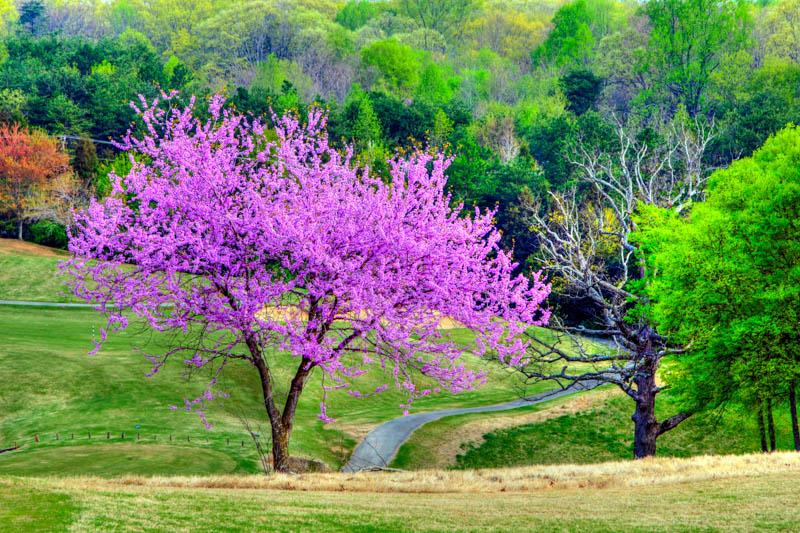Redbud trees may face issues such as canker disease, causing branch dieback, and verticillium wilt, leading to wilting and discoloration of leaves. Pests like scale insects and leafhoppers can also pose threats, while improper watering can result in root rot, weakening the tree's overall health.
The Redbud tree, belonging to the genus Cercis, is a captivating addition to any landscape, heralding spring with its profusion of vibrant, pink to purple flowers that bloom directly on branches before the foliage emerges.
This small to medium-sized deciduous tree exhibits a multi-branched, spreading habit, creating a graceful, rounded canopy that provides dappled shade, perfect for understory planting. Leaves are heart-shaped, adding a soft texture to the garden throughout the growing season, transitioning to striking yellow hues in fall.

Eastern Redbud (Cercic canadensis)
Redbuds are known for their adaptability, thriving in a variety of soil types, as long as they are well-drained. Their resilience, paired with their ornamental appeal, makes Redbuds a favored choice among gardeners.
They also play a vital role in supporting local ecosystems, attracting many pollinators, such as bees, and serving as a host plant for several butterfly species, thereby contributing to biodiversity in the garden.
Redbud trees, with their striking blooms and unique form, are generally resilient but can occasionally fall prey to pest issues. Common culprits include scale insects, which suck sap from the branches, and leafhoppers that feed on the foliage, potentially transmitting diseases. Caterpillars might chew on the leaves, causing aesthetic damage. Ensuring proper care and monitoring for early signs of infestation can help maintain the tree’s vigor.
| Hardiness |
4 - 9 |
|---|---|
| Climate Zones | 1, 1A, 1B, 2, 2A, 2B, 3, 3A, 3B, 4, 5, 6, 7, 8, 9, 10, 11, 12, 13, 14, 15, 16, 17, 18, 19, 20, 21, 22, 23, 24 |
| Plant Type | Shrubs, Trees |
| Plant Family | Fabaceae |
| Genus | Cercis |
| Exposure | Full Sun, Partial Sun |
| Season of Interest |
Spring (Early, Mid) Fall Winter |
| Height |
5' - 30' (150cm - 9.1m) |
| Spread |
3' - 35' (90cm - 10.7m) |
| Maintenance | Low |
| Water Needs | Average |
| Soil Type | Chalk, Loam, Sand, Clay |
| Soil pH | Acid, Neutral, Alkaline |
| Soil Drainage | Moist but Well-Drained, Well-Drained |
| Characteristics | Showy |
| Tolerance | Clay Soil, Deer |
| Attracts | Bees, Butterflies, Birds, Hummingbirds |
| Landscaping Ideas | Beds And Borders, Patio And Containers |
| Garden Styles | City and Courtyard, Informal and Cottage, Traditional Garden |
| Hardiness |
4 - 9 |
|---|---|
| Climate Zones | 1, 1A, 1B, 2, 2A, 2B, 3, 3A, 3B, 4, 5, 6, 7, 8, 9, 10, 11, 12, 13, 14, 15, 16, 17, 18, 19, 20, 21, 22, 23, 24 |
| Plant Type | Shrubs, Trees |
| Plant Family | Fabaceae |
| Genus | Cercis |
| Exposure | Full Sun, Partial Sun |
| Season of Interest |
Spring (Early, Mid) Fall Winter |
| Height |
5' - 30' (150cm - 9.1m) |
| Spread |
3' - 35' (90cm - 10.7m) |
| Maintenance | Low |
| Water Needs | Average |
| Soil Type | Chalk, Loam, Sand, Clay |
| Soil pH | Acid, Neutral, Alkaline |
| Soil Drainage | Moist but Well-Drained, Well-Drained |
| Characteristics | Showy |
| Tolerance | Clay Soil, Deer |
| Attracts | Bees, Butterflies, Birds, Hummingbirds |
| Landscaping Ideas | Beds And Borders, Patio And Containers |
| Garden Styles | City and Courtyard, Informal and Cottage, Traditional Garden |
Create a membership account to save your garden designs and to view them on any device.
Becoming a contributing member of Gardenia is easy and can be done in just a few minutes. If you provide us with your name, email address and the payment of a modest $25 annual membership fee, you will become a full member, enabling you to design and save up to 25 of your garden design ideas.
Join now and start creating your dream garden!
Create a membership account to save your garden designs and to view them on any device.
Becoming a contributing member of Gardenia is easy and can be done in just a few minutes. If you provide us with your name, email address and the payment of a modest $25 annual membership fee, you will become a full member, enabling you to design and save up to 25 of your garden design ideas.
Join now and start creating your dream garden!